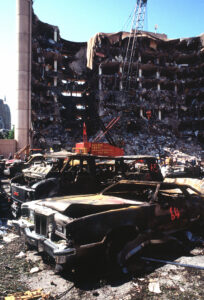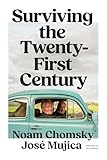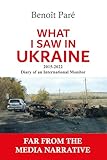
The bombed remains of automobiles with the bombed Federal Building in the background, April 19, 1995.
In other circumstances, we don’t have to wonder. We know.
It happens to writers a lot. It’s often our and stock-in-trade.
I know exactly what I was thinking after the Oklahoma City bombing thirty years ago today, and it was not popular. But I recorded it in the April 25, 1995 edition of The Shorthorn at the University of Texas-Arlington. And the math sucks. It’s aged much better than the author.
In the Aftermath
To terrorize is to dominate or coerce by intimidation, the threat of violence, or the calculated perpetration of destruction, catastrophe, assassination, murder, etc. In the popular mind, terrorism is qualified by additional connotations. People recognize it as a vicious, cold-blooded attack on defenseless civilians or bystanding innocents. Few crimes are judged with such an unchallenged sense of vehement righteousness. Perpetrators of terrorism are hounded with unparalleled sanctimony and fanatic zeal. I read President Clinton’s pledge in the newspaper: “Nobody can hide any place in this country; nobody can hide any place in this world from the terrible consequences of what has been done.”
Indeed, I think . . . unless they are American.
Reports of the Oklahoma City bombing shock, enrage, and sadden me, but an ancient adage haunts my conscience: Those who live by the sword, die by the sword.
For the last four decades, the United States has perpetrated terrorist activities around the world. Our remorseless work in Vietnam, before and during the war, provided a chilling catalogue of American terrorism. The CIA-planned and CIA-executed assassination of the democratically-elected president of Chile, Salvador Allende, evidenced a harrowing propensity for terrorist realpolitik. And the United States has repeatedly installed and/or subsidized puppet dictators around the world who perform terrorist acts on their own constituencies.
On a subtler level, in cases such as Israel and, until recently, South Africa, we support governments that permit, if not directly sanction, terrorist enterprises against their own indigenous populations, ranging from summary executions to simple violations of the most basic human rights.
I see tattered infant-victims of the bombing in Oklahoma City and cringe, rueful and angry.
But my jaw also stiffens as I recall the Guatemalan and El Salvadoran “Death Squads,” the genocidal military wings of regimes we encouraged and assisted in rises to power in Central America.
 In Guatemala, we supported the coup against and eventual overthrow of democratically elected president Jacob Arbenz. The faction we bet on—and invested in—began an incomprehensible reign of terror, decimating over 440 indigenous villages, conducting an estimated 100,000 political killings (more than 40,000 termed “disappearances”), and leaving over 200,000 children orphaned. And our man in Chile, General Augusto Pinochet, upstaged his Guatemalan counterparts, employing tortures that included inserting sabers in vaginas and disemboweling female victims while their families watched.
In Guatemala, we supported the coup against and eventual overthrow of democratically elected president Jacob Arbenz. The faction we bet on—and invested in—began an incomprehensible reign of terror, decimating over 440 indigenous villages, conducting an estimated 100,000 political killings (more than 40,000 termed “disappearances”), and leaving over 200,000 children orphaned. And our man in Chile, General Augusto Pinochet, upstaged his Guatemalan counterparts, employing tortures that included inserting sabers in vaginas and disemboweling female victims while their families watched.
And who can forget the “fraidy-Eighties” under Ronnie Reagan?
No one in Nicaragua can.
Men, women and children no different than the citizens of Oklahoma City were afraid all the time, and not just over one incident, but several every week. Besides funding and arming the Contras, we also published and distributed a terrorist handbook for their training. The CIA called it a “Freedom Fighters Manual,” but it included, among other things, detailed instructions (with illustrations) for making and utilizing Molotov cocktails.
And these are just are just a few of the examples where U.S. involvement in terrorist activities actually became public. There were no doubt countless others. In fact, by popular definition, the largest single terrorist atrocity in human history was the allied firebombing of Dresden, Germany in World War II. Although it occurred during wartime, it was a vicious, calculated attack on a virtually defenseless civilian community.
The second and third largest terrorist atrocities in world history were probably our nuclear strikes in Japan. These incidents pale in comparison to the widespread pogroms of Hitler, Belgium’s King Leopold, and the Catholic Church, but genocide is not a single act or terrorism—it constitutes a regimen of terrorism (of which our nation could be accused of domestically regarding indigenous people and Blacks and also in much of the Third World in general).
As Americans, we are largely and more recently unaccustomed to displays of first-hand terrorist bloodshed, but, for much of the rest of the world, it’s nothing out of the ordinary. They live with it every day.
I shudder at the scenes from Oklahoma City; but I also quake at our bloody ignorance. Did we think our acts of terror would never be reciprocated? Or that our fellow citizens were incapable of them?
Did we really think we could be immune from terrorism after having so long been one of its chief contagions?!
American terrorism has, however, evolved. Now, it’s openly encouraged and sanctioned by our commander-and-chief.










